Gorenje BM 2120 AX User Manual
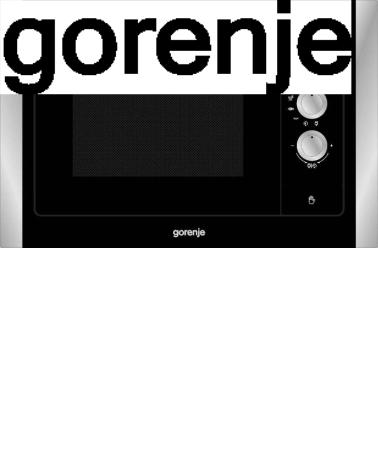
Instructions for Use
Microwave
Käyttöohjeet
Mikroaaltouuni
Bruksanvisning
Mikrovågsugn
Brugsanvisning
Mikrobølgeovn
Bruksanvisning
Mikrobølgeovn
BM 2120 AX

Dear Customer:
First of all, we would like to thank you for preferring our product. We are sure that this modern, functional and practical microwave oven, manufactured with the highest quality materials, will live up to your expectations.
Please read the instructions in this book carefully, as they will help you to get better results in using your microwave oven.
PLEASE KEEP THE DOCUMENTATION ON THIS PRODUCT FOR FUTURE REFERENCE.
Keep your instructions manual close at hand. If you give the appliance to another person, remember to give them the corresponding manual as well!
Tips on environmental protection
Eliminating the packaging 
EN
The packaging carries the Green Dot. Use the right bins when discarding all of the packaging materials, such as the cardboard, styrene and plastic films. This will ensure that the packaging materials are recycled.
Disposal of old electrical appliances 
The European Directive 2002/96/EC on Waste
Electrical and Electronic Equipment (WEEE), requires that old household electrical appliances must not be disposed of in the normal unsorted municipal waste stream. Old appliances must be collected separately in order to optimise the recovery and recycling of the materials they contain and reduce the impact on human health and the environment.
The crossed out “wheeled bin” symbol on the product reminds you of your obligation, that when you dispose of the appliance it must be separately collected.
Consumers should contact their local authority or retailer for information concerning the correct disposal of their old appliance.
Before you dispose of your appliance, remove the power cable, cut it and dispose of it.
1

EN |
|
Table of contents |
|
Safety tips............................................................................................................................................ |
3 |
Installation instructions ..................................................................................................................... |
5 |
Description of the appliance.............................................................................................................. |
6 |
Advantages of the microwave oven.................................................................................................. |
7 |
Microwave oven operating mode...................................................................................................... |
7 |
Instructions for use ............................................................................................................................ |
8 |
Setting the clock ................................................................................................................................. |
8 |
Safety lock........................................................................................................................................... |
8 |
Function: Microwave .......................................................................................................................... |
9 |
Special function: Drink....................................................................................................................... |
9 |
Special function: Defrost and Heat ................................................................................................... |
9 |
Defrosting by time (manual) ............................................................................................................ |
10 |
During operation............................................................................................................................... |
11 |
Function interruption....................................................................................................................... |
11 |
End of programme.......................................................................................................................... |
11 |
General tips for defrosting .............................................................................................................. |
13 |
Cooking with microwaves................................................................................................................ |
14 |
Important tips!................................................................................................................................. |
14 |
Tables and suggestions – Cooking vegetables .............................................................................. |
15 |
Tables and suggestions – Cooking fish .......................................................................................... |
15 |
What type of containers may be used? .......................................................................................... |
16 |
Microwave function......................................................................................................................... |
16 |
Test the dishes ............................................................................................................................... |
16 |
Aluminium containers and foils....................................................................................................... |
16 |
Lids................................................................................................................................................. |
16 |
What type of containers may be used? .......................................................................................... |
17 |
Table – dishware ............................................................................................................................ |
17 |
Cleaning and care............................................................................................................................. |
18 |
Troubleshooting ............................................................................................................................... |
19 |
Technical Features ........................................................................................................................... |
20 |
Description of functions of buttons.................................................................................................. |
20 |
Specifications ................................................................................................................................. |
20 |
2

Safety tips
•Warning! In order to avoid any type of flame, only use the microwave when you are there to supervise. Very high power levels or very long cooking times may heat the food to excess and cause fires.
•If you see smoke or fire, keep the door closed, to put out the flames. Switch off the appliance and remove the plug from the socket.
•Warning! This appliance is not intended for use by persons (including children) with reduced physical, sensory or mental capabilities, or lack of experience and knowledge, unless they have been given supervision or instruction concerning use of the appliance by a person responsible for their safety. Children should be supervised to ensure that they do not play with the appliance.
•Warning! Considerable care is required when the grill is functioning. Keep children away from the appliance!
•Our appliances meet the necessary regulations and rules for technical equipment. However, these do not cover all the possible accident risks.
•When using inflammable materials, such as plastics or paper containers, to heat or cook foods, the cooking process must be monitored on a continuous basis, because of the risk of fire.
•Before using dishes or containers in the microwave, check if they are microwavesaveOnly use microwave-safe dishes.
•The power cable should not touch damp, sharp-edged objects or the appliance when it is hot.
EN
•When connecting electrical appliances in the vicinity of the microwave, ensure that the power cables do not touch the microwave when it is hot and that they do not get caught in the oven door, in order to avoid damage and danger.
•Pay attention to operating faults. The appliance may not be used in the following cases:
-If the door does not close properly;
-If the door-hinges are damaged;
-If the contact surfaces between the door and the front are damaged;
-If the glass in the window is damaged;
-If there is often an electrical arch inside the oven, without the presence of any metallic object.
•The ventilation holes may not be covered.
Cleaning/ maintenance:
•Before carrying out any maintenance or cleaning, remove the plug from the socket.
•Please remember the cleaning tips contained in the section “Cleaning and care”.
•The contact surfaces (the front of the cavity and the inside of the door) must be kept quite clean in order to guarantee correct functioning. Clean the contact surfaces with a neutral detergent and a cloth that does not scratch or cause any type of friction.
•Warning: Never use the appliance if the contact surfaces are damaged. Only use the appliance again if it has been repaired by a technician from the Technical Support
Service.
3
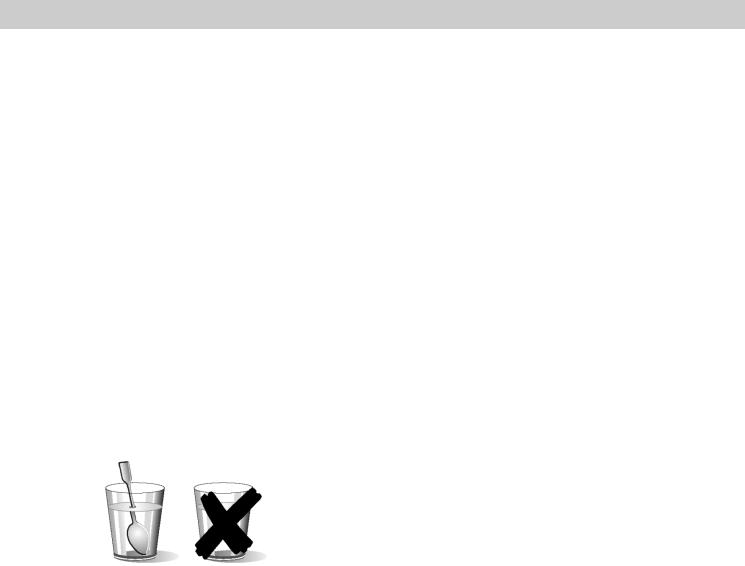
EN
Safety tips
The following tips avoid damage to the appliance:
•Do not switch on the appliance without the rotating base and respective plate.
•Do not switch on the appliance when it is empty. This may result in overload, if there is no food inside.
•Only use microwave-safe dishes.
•Do not keep any inflammable object inside the oven, because it may go on fire when the oven is switched on.
•Eggs with shells and whole boiled eggs should not be heated in microwave ovens because they may explode.
•Do not heat pure alcohol or alcoholic drinks in the microwave.
THIS IS A FIRE HAZARD.
•Warning: do not heat liquids or other foods in closed containers, because they could easily explode.
Be careful when heating liquids!
•When heating liquids (water, coffee, tea, milk, etc.), they may almost reach boiling point inside the appliance and if they are removed suddenly, may fly out of the container. This may cause injuries and burns!
•In order to avoid this type of situations, put a plastic spoon or glass rod in the container when heating liquids.
4
Be careful!
•When heating small amounts of food, it is very important not to select long periods of time or very high power levels, because the food may overheat or burn. For example, bread may burn after 3 minutes if a very high power level is selected.
•To toast, only use the grill function and supervise the oven at all times. If you are using the combined function (microwave and grill) to toast, the bread will go on fire in a very short period of time.
•Always heat baby food in jars or bottles without lids or teats. After heating the food, shake or stir it well to ensure that the heat is uniformly distributed. Check the temperature of the food before giving it to the child,
Burning hazard!
In case of repair:
•¡Warning – Microwaves! The outer protection should not be removed. Any repair or maintenance carried out by persons that have not been authorised by the manufacturer is dangerous.
•Warning: The light bulb may only be replaced by the Technical Support Service.
•If the power cable is damaged, only the
Technical Support Service may replace it with one of the same characteristics, in order to avoid damage.
Repairs and maintenance, especially of charged parts, may only be carried out by technicians that have been authorised by the manufacturer.

Installation instructions
Use the “open” button to open the door and remove all packaging materials. Then clean the inside and the accessories with a damp cloth and dry them. Do not use abrasive or strong-smelling products.
Ensure that the following parts are in good condition:
•Door and hinges
•Front of the microwave
•Inner and outer surfaces of the appliance
DO NOT USE THE APPLIANCE if you notice any kind of defect in the aforementioned parts. If this occurs, contact the Technical Support Service.
Place the appliance on a stable, flat surface.
Fit the rotating base in the centre of the microwave cavity and place the rotating plate on top until it clicks into position. Whenever the microwave is used, both the rotating plate and the respective base must be inside the oven and correctly positioned. The rotating plate turns clockwise and anti-clockwise.
Warning! The microwave oven may be wrapped in a protective film. Before switching it on for the first time, carefully remove this film, starting at the underside.
EN
In order to ensure proper ventilation for the appliance, install the microwave in a kitchen unit with an opening on the top (see attached sheets).
Warning: after installing the microwave, it is necessary to guarantee access to the electrical socket.
During installation, ensure that the power cable does not come into contact with the back of the appliance, because the high temperatures may damage the cable.
If you are installing a microwave and a conventional oven in the same column, the microwave must not be placed under the oven, because of the formation of condensation.
The appliance must not be placed in the vicinity of heating elements, radios or television sets.
The appliance is equipped with a power cable and a plug for single phase current.
WARNING: The microwave MUST ONLY BE CONNECTED TO GROUNDED ELECTRICAL SOCKETS.
In case of fault, the manufacturer and the seller will not accept any responsibility if the installation instructions have not been properly followed.
5
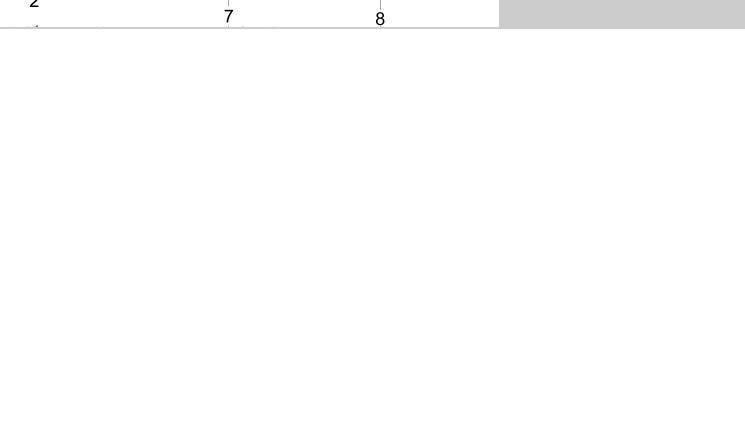
EN
Description of the appliance
1. |
Glass window on the door |
5. |
Open button |
2. |
Catch |
6. |
Slot for rotating base |
3. |
Mica covers |
7. |
Rotating base |
4. |
Control panel |
8. |
Rotating plate |
6
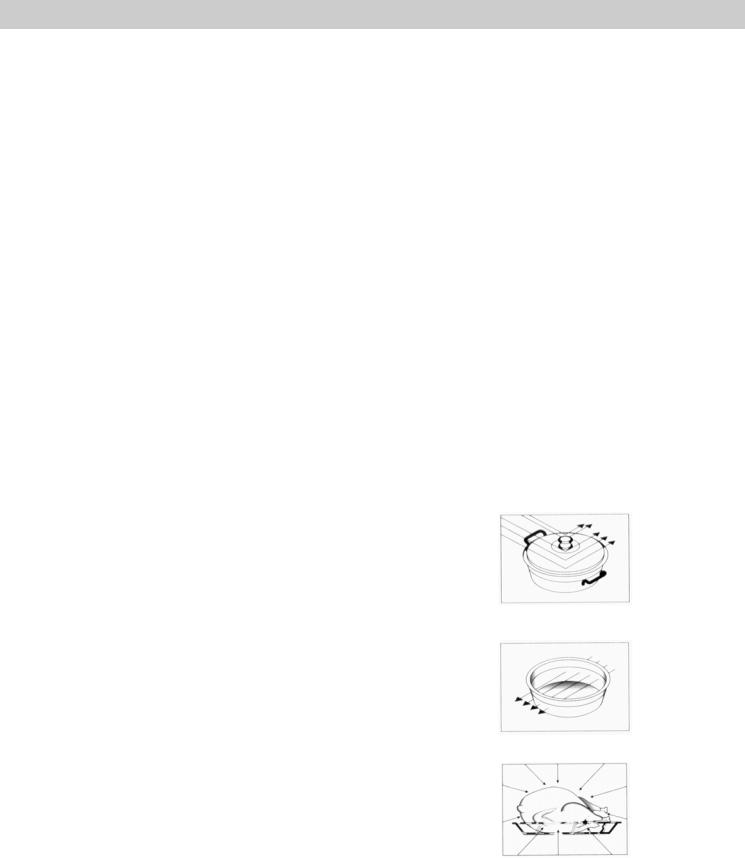
EN
Advantages of the microwave oven
In a conventional cooker, the heat that is radiated through the resistances or gas burners slowly penetrates the foods from the outside in.
Therefore, there is a great loss of energy in heating the air, the oven components and the containers holding the food.
In the microwave, the heat is generated by the foods themselves, i.e. the heat goes from the inside out. There is no loss of heat to the air, the walls of the cavity or the containers (as long as they are microwave-safe containers). This means that only the food is heated.
To sum up, microwave ovens have the following advantages:
Why the food is heated
Most foods contain water and the water molecules vibrate with the microwaves.
The friction between the molecules generates heat, which raises the temperature of the foods, defrosting or cooking them or keeping them hot.
Because heat is formed inside the foods:
•The foods may be cooked without any liquids or oils, or with very little of these;
•Defrosting, heating or cooking in the microwave oven is faster than in a conventional oven;
•The vitamins, minerals and nutritious substances are conserved;
1.Savings in cooking time; in general, there is a ¾ reduction in time compared to conventional cooking.
2.Ultra fast defrosting of foods, thus reducing the danger of bacteria developing.
3.Energy-saving.
4.Conservation of the nutritional value of foods due to the reduction in cooking time.
•Neither the natural colour nor the aroma are altered.
The microwaves go through porcelain, glass, cardboard or plastic, but not trough metal. For this reason, metallic containers or containers with metallic parts should not be used in the microwave oven.
Microwaves are reflected by metal...
Microwave oven operating mode
The microwave oven contains a high voltage valve called a Magnetron, which converts the electrical energy into microwave energy. These electromagnetic waves are channelled towards the inside of the oven by a wave guide and distributed using a metallic disperser or a rotating plate.
Inside the oven, the microwaves are propagated in all directions and reflected by the metallic walls, thus uniformly penetrating the foods.
... they go through glass and porcelain...
... and are absorbed by the foods.
7

EN
Instructions for use
Warning: Never use the microwave when it is empty, i.e. when it does not contain any food.
Look at the diagram and proceed as follows:
1.Plug the appliance into an appropriate electrical socket (see tips on the last page).
2.To open the door, press the OPEN BUTTON.
The inside lighting of the microwave comes on.
3.Place the container with the food on the plate.
4.Select the function and the cooking time, according to the description contained in the following sections.
5.Close the door and press the START-Button
6.The microwave starts to function and the screen displays the remaining operating time.
Setting the clock
1.When you are not using the oven press the
CLOCK button until the numbers start to flash.
2.Enter the hours with the help of the ROTATING BUTTON, turning it in any direction.
3.Press again the CLOCK button to set the minutes.
4.Enter the minutes with the help of the
ROTATING BUTTON, turning it in any direction.
5.To finish, press the CLOCK button again.
Safety lock
The safety lock can be activated and deactivated by pressing the safety lock button for 3 seconds while the microwave is on stand-by position. When this happen, all the functions are deactivated and on the screen displays 4 horizontal middle size bars on each digit and the dots keep flashing.
8

EN
Function: Microwave
1.Set the function selector to the position that corresponds to the desired power level, according to the following table.
Position |
Power level |
Power |
|
Maximum |
800 W |
|
|
|
|
Medium |
600 W |
|
|
|
|
Minimum |
320 W |
|
|
|
|
Keep hot |
130 W |
2.Enter the operating time with the help of the
ROTATING BUTTON, turning it in any direction.
3.Press the START button. The microwave starts to function and the screen displays the remaining operating time.
Special function: Drink
1.Place the drink (approx. 150 to 300 ml of coffee, tea, milk, water, etc.) in a heat resistant recipient on the turntable.
2.Set the function selector to the appropriate position  .
.
3.Press the START button. The microwave starts to function and the screen displays the remaining operating time (10 min.).
Special function: Defrost and Heat
1.Remove the lid of the packaging (precooked foods: 300g – 400g; e.g. cannelloni, macaroni, gnocchi) and put the contents on a plate or place the packaging directly on the rotating plate in the microwave.
2.Set the function selector to the appropriate position  .
.
3.Press the START button. The oven starts to function and the screen displays the remaining operating time.
4.Turn the foods around at the moment the microwave beeps and starts to flash on the screen:  . Close the door again and press the START button.
. Close the door again and press the START button.
9

EN
Defrosting by weight (automatic)
1. Just use this function to defrost meat, fish and poultry. For other food types like bread and fruit follow the instructions on “Defrosting by weight”.
2. Set the function selector to the appropriate
position  .
.
3. Indicate the defrosting time by using the
ROTATING BUTTON, turning it in any direction.
4. Press the START button. The oven starts to function and the screen displays the remaining operating time.
5. Turn the foods around at the moment the microwave beeps and starts to flash on the
screen:  . Close the door again and press the START button.
. Close the door again and press the START button.
Defrosting by time (manual)
1. Set the function selector to the appropriate
position  .
.
2. Indicate the defrosting time by using the
ROTATING BUTTON, turning it in any direction.
3. Press the START button. The oven starts to function and the screen displays the remaining operating time.
4. Turn the foods around at the moment the microwave beeps and starts to flash on the
screen:  . Close the door again and press the START button.
. Close the door again and press the START button.
10

During operation...
It is possible to open the door of the oven at any moment while the foods are being cooked. In this case:
•THE PRODUCTION OF MICROWAVES IS
AUTOMATICALLY INTERRUPTED;
•The timer stops and the screen displays the remaining operating time.
If you wish, you may:
1.Move or turn the foods around to improve uniformity of the heating process;
2.Select another function, placing the function selector in another position;
3.Change the operating time that is left, by turning the Rotating Button.
Close the door of the microwave and press the START button. The microwave starts to function.
Function interruption
To interrupt the programme, press the STOP button or open the door of the appliance. If you wish to cancel the cooking process, close the door again and press the STOP button. The oven will beep and the screen displays the time.
EN
End of programme
When the programme is finished, the microwave beeps 3 times and the screen displays “End”. The beeps are repeated every 30 seconds, until the door is opened or the “STOP” button is pressed.
After the programme end, it is possible that the ventilator keeps on working to refrigerate the microwave inside. The ventilator turns off automatically after a certain period of time. While the ventilator is working, the inside light is on.
11

EN
Defrosting
The following table is a general guideline for the various defrosting and resting times required (to guarantee that the food reaches a uniform
temperature) according to the type and weight of the foods. It also contains the respective recommendations for defrosting different foods.
|
Food |
|
|
Weight |
|
Defrosting |
|
Resting time |
|
Comment |
|
|
|
|
Time |
|
|
||||
|
|
|
|
|
|
|
|
|
|
|
|
|
|
|
100 g |
3-4 min |
|
5-10 min |
Turn around 1 x |
||
|
|
|
|
200 g |
6-7 min |
|
5-10 min |
Turn around 1 x |
||
|
Pieces of meat, veal, beef, |
|
500 g |
14-15 min |
|
10-15 min |
Turn around 2 x |
|||
|
pork |
|
700 g |
20-21 min |
|
20-25 min |
Turn around 2 x |
|||
|
|
|
|
1000 g |
29-30 min |
|
25-30 min |
Turn around 3 x |
||
|
|
|
|
1500 g |
42-45 min |
|
30-35 min |
Turn around 3 x |
||
|
Stewed meat |
|
500 g |
12-14 min |
|
10-15 min |
Turn around 2 x |
|||
|
|
1000 g |
24-25 min |
|
25-30 min |
Turn around 3 x |
||||
|
|
|
|
|
||||||
|
|
|
|
100 g |
4-5 min |
|
5-6 min |
Turn around 1 x |
||
|
Minced meat |
|
300 g |
8-9 min |
|
8-10 min |
Turn around 2 x |
|||
|
|
|
|
500 g |
12-14 min |
|
15-20 min |
Turn around 2 x |
||
|
|
|
|
125 g |
3-4 min |
|
5-10 min |
Turn around 1 x |
||
|
Sausage |
|
250 g |
8-9 min |
|
5-10 min |
Turn around 1 x |
|||
|
|
|
|
500 g |
15-16 min |
|
10-15 min |
Turn around 1 x |
||
|
Poultry, poultry parts |
|
200 g |
7-8 min |
|
5-10 min |
Turn around 1 x |
|||
|
|
500 g |
17-18 min |
|
10-15 min |
Turn around 2 x |
||||
|
|
|
|
|
||||||
|
|
|
|
1000 g |
34-35 min |
|
15-20 min |
Turn around 2 x |
||
|
Chicken |
|
1200 g |
39-40 min |
|
15-20 min |
Turn around 2 x |
|||
|
|
|
|
1500 g |
48-50 min |
|
15-20 min |
Turn around 2 x |
||
|
Fish |
|
100 g |
3-4 min |
|
5-10 min |
Turn around 1 x |
|||
|
|
200 g |
6-7 min |
|
5-10 min |
Turn around 1 x |
||||
|
|
|
|
|
||||||
|
Trout |
|
200 g |
6-7 min |
|
5-10 min |
Turn around 1 x |
|||
|
Shrimps |
|
100 g |
3-4 min |
|
5-10 min |
Turn around 1 x |
|||
|
|
500 g |
12-15 min |
|
10-15 min |
Turn around 2 x |
||||
|
|
|
|
|
||||||
|
|
|
|
200 g |
4-5 min |
|
5-8 min |
Turn around 1 x |
||
|
Fruit |
|
300 g |
8-9 min |
|
10-15 min |
Turn around 2 x |
|||
|
|
|
|
500 g |
12-14 min |
|
15-20 min |
Turn around 3 x |
||
|
|
|
|
100 g |
2-3 min |
|
2-3 min |
Turn around 1 x |
||
|
Bread |
|
200 g |
4-5 min |
|
5-6 min |
Turn around 1 x |
|||
|
|
500 g |
10-12 min |
|
8-10 min |
Turn around 2 x |
||||
|
|
|
|
|
||||||
|
|
|
|
800 g |
15-18 min |
|
15-20 min |
Turn around 2 x |
||
|
Butter |
|
250 g |
8-10 min |
|
10-15 min |
Turn around 1 x, keep |
|||
|
|
|
|
|
|
|
|
covered |
||
|
|
|
|
|
|
|
|
|
|
|
|
Cottage cheese |
|
250 g |
6-8 min |
|
5-10 min |
Turn around 1 x, keep |
|||
|
|
|
|
|
|
|
|
covered |
||
|
|
|
|
|
|
|
|
|
|
|
|
Cream |
|
250 g |
7-8 min |
|
10-15 min |
Remove the lid |
|||
12

Defrosting
General tips for defrosting
1.Only use microwave-safe dishes for defrosting
(porcelain, glass, suitable plastic).
2.The tables refer to defrosting of raw foods.
3.The defrosting time depends on the quantity and the height of the food. When freezing foods, prepare for the defrosting process.
Distribute the food in parts that match the size of the container.
4.Distribute the food as well as possible inside the microwave. The thickest parts of the fish or the chicken legs should be placed on top. The most delicate parts may be protected using aluminium foil. Important: the aluminium foil should not come in contact with the walls of the cavity, as this could cause an electrical arch.
5.The most dense parts should be turned around several times.
6.Distribute the frozen food in the most uniform manner possible, because the thin, narrow parts defrost fast than the thickest parts at the top.
7.Foods that are rich in fats, such as butter, cottage cheese and cream, should not be entirely defrosted. If they are at room temperature, they will be ready to serve within a few minutes. In the case of deep-frozen cream, if there are little bits of ice, the cream should be whipped before eating.
EN
8.Place poultry on a turn over plate so that the juices may drain more easily.
9.Bread should be wrapped in a napkin so that it does not get too dry.
10.Remove frozen foods from its packaging and do not forget to remove any metal clips. If the containers that are used to keep the foods in the freezer may also be used for heating and cooking, just remove the lid. Otherwise, place the foods in containers that are suitable for microwave ovens.
11.The liquid that results in the defrosting process, particularly in the case of poultry, should be discarded and under no circumstances should it come in contact with other foods.
12.Bear in mind that a resting period is required in defrosting function, so that the food is totally defrosted. This normally takes between
15 to 20 minutes.
13

EN
Cooking with microwaves
Before using a container, check if it is suitable for using in a microwave oven (see: “What kind of containers may be used?”).
Cut the food before starting to prepare it.
When heating liquids, use containers with a large neck, so that the steam may evaporate easily.
Prepare foods according to the tips and pay attention to the cooking times and power levels indicated in the tables.
Remember that the values given are merely a guideline and that they may vary depending on the initial state, temperature, humidity and type of food. We recommend that the times and power levels be adjusted to each situation. Depending on the food, the cooking time should be extended or shortened and the power level should be raised or reduced.
Cooking with microwaves...
1.The greater the quantity of food, the longer the cooking time. Remember the following rules:
•Double the quantity - double the time
•Half the quantity – half the time
2.The lower the temperature, the longer the cooking time.
3.Liquid foods heat faster.
4.Proper distribution of the food on the rotating plate facilitates uniform cooking. If the solid foods are placed on the outer part of the plate and the least solid in the middle of the plate, it will be possible to heat different kinds of food at the same time.
5.The door of the appliance may be opened at any time. The appliance is automatically switched off. The microwave only continues to function if the door is closed.
6.Foods that are covered require less cooking time and their characteristics are better preserved. The lid must allow the microwaves to pass through and should have little openings to allow the steam to come out.
Important tips!
•Eggs with shells and whole eggs should not be heated in microwave ovens as they may explode.
•Before heating or cooking foods with shells or skin (e.g., apples, tomatoes, potatoes, sausages) prick them with a fork so that they do not open up.
•When foods are prepared with very little humidity (e.g. defrosting bread, making
14
popcorn, etc.), the humidity evaporates very fast. The appliance then functions with a vacuum and the food may be carbonised. This situation may cause damage to the appliance and to the container being used. Therefore, the oven should be set only for the necessary time and the cooking process should be supervised.
•It is not possible to heat large quantities of oil (fry) in the microwave.
•Do not heat liquids in airtight containers.
Explosion hazard!
•Alcoholic drinks may not be heated to high temperatures. Therefore, the oven should be set only for the necessary time and the cooking process should be supervised.
•Do not heat any kind of explosive material or liquid in the microwave.
•Remove precooked foods from the packaging, because the latter is not always heat-resistant. Follow the manufacturer’s instructions.
•If there are various different containers, such as cups for example, place them uniformly on the rotating plate.
•Always heat baby bottles or jars of baby food without lids or teats. After heating, shake or stir it well to ensure that the heat is uniformly distributed. The temperature of the containers is considerably lower than that of the heated food. Check the temperature of the food before giving it to the child, to avoid burns.
•Plastic bags should not be closed with metal clips, but with plastic ones. The bag should be perforated several times so that the steam may come out easily.
•When heating or cooking foods, ensure that they reach a minimum temperature of 70°C.
•During the cooking process, water vapour may form on the glass window of the door and may drip down after a time. This is a normal situation and may even be significant if the room temperature is low. This does not represent a hazard for the safety of the appliance. After cooking, clean the water resulting from the condensation.
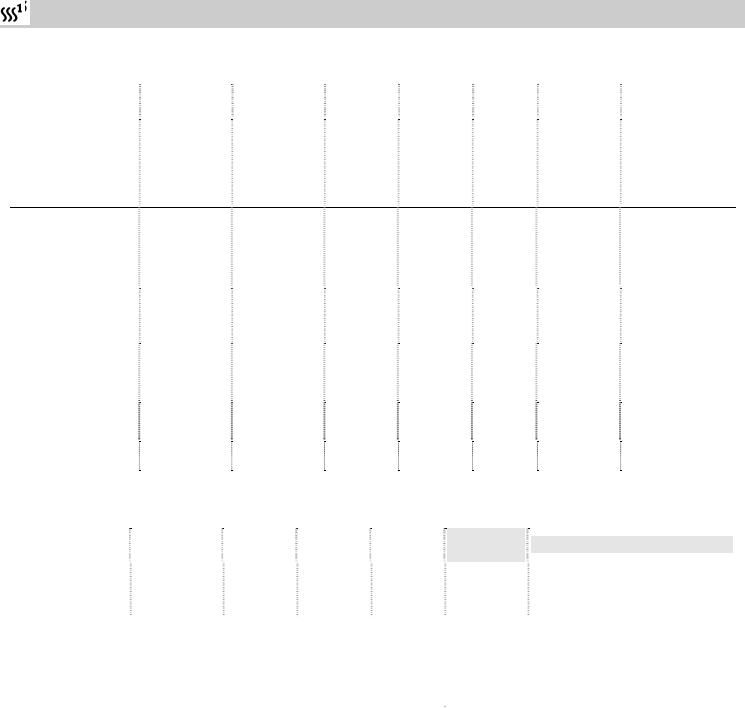
EN
Cooking with microwaves
Tables and suggestions – Cooking vegetables
|
Food |
|
Quantity (g) |
|
Added |
Power |
Power |
Time |
Resting |
|
Tips |
|
|
|
|
liquid |
(Watt) |
level |
(min.) |
time (min.) |
|
|
|||
|
|
|
|
|
|
|
|
Cauliflower |
500 |
1/8 l |
800 |
9-11 |
Broccoli |
300 |
1/8 l |
800 |
6-8 |
Mushrooms |
250 |
- |
800 |
6-8 |
2-3 |
Spread |
some |
2-3 |
butter on |
top. |
2-3 |
Cut in slices. |
|
|
|
|
Peas & carrots, |
300 |
½ cup |
800 |
7-9 |
2-3 |
Cut in cubes or |
|
frozen carrots |
|
|
|
|
|
slices. |
|
|
250 |
2-3 soup- |
800 |
8-10 |
2-3 |
|
|
|
|
spoonfuls |
|
|
|
|
|
Potatoes |
250 |
2-3 soup- |
800 |
5-7 |
2-3 |
Peel, |
cut in |
|
|
spoonfuls |
|
|
|
equal- |
sized |
|
|
|
|
|
|
parts. |
|
Peppers |
250 |
- |
800 |
5-7 |
2-3 |
Cut in pieces or |
|
Leeks |
250 |
½ cup |
800 |
5-7 |
2-3 |
slices. |
|
|
|
|
|
|
|
|
|
Frozen Brussels |
300 |
½ cup |
800 |
6-8 |
2-3 |
|
|
sprouts |
|
|
|
|
|
|
|
Cabbage |
250 |
½ cup |
800 |
8-10 |
2-3 |
|
|
|
|
|
|
|
|
|
|
Tables and suggestions – Cooking fish
|
Food |
|
Quantity (g) |
|
|
Power |
|
Power |
|
Time |
|
Resting |
|
|
Tips |
|
|
|
|
|
|
(Watt) |
|
level |
|
(min.) |
|
time (min.) |
|
|
|
|
|||
|
|
|
|
|
|
|
|
|
|
|
|
|
|
||||
|
|
|
|
|
|
|
|
|
|
|
|
|
|
Cook |
with the lid |
on. |
Turn |
|
Fillets of fish |
500 |
|
600 |
|
|
10-12 |
|
3 |
|
them |
around when |
half |
the |
|||
|
|
|
|
|
|
|
|
|
|
|
|
|
|
time has elapsed. |
|
|
|
|
|
|
|
|
800 |
|
|
3-5 |
|
|
|
Cook with the lid on. Turn |
|||||
|
Whole fish |
800 |
|
|
|
|
|
|
them |
around when |
half |
the |
|||||
|
|
|
|
|
|
|
|
|
2-3 |
|
time has elapsed. It may be |
||||||
|
|
|
|
|
320 |
|
|
10-12 |
|
|
|
necessary to cover the ends of |
|||||
|
|
|
|
|
|
|
|
|
|
|
|
|
|
the fish. |
|
|
|
15

EN
What type of containers may be used?
Microwave function
In the microwave function, it is important to remember that the microwaves are reflected by metallic surfaces. Glass, porcelain, ceramic, plastic and paper will allow the microwaves to pass through.
Therefore, metallic pans and dishes for cooking or containers with metallic components or decorations may not be used in the microwave.
Glassware and ceramic with metallic decorations or parts (e.g. lead glass) may not be used.
The ideal materials to be used for cooking in a microwave oven are refractory, heat-resistant glass, porcelain or ceramic. Very fine crystal and porcelain should only be used for a short time, to defrost or reheat foods that have already been cooked.
Test the dishes
Place the dish inside the oven at the maximum power level for 20 seconds. If it is cold or not very hot, it is suitable. However, if it gets very hot or causes an electrical arch, it is not suitable.
Hot foods transmit heat to the dish, which may become very hot. Therefore, always use a glove!
Aluminium containers and foils
Precooked foods in aluminium containers or wrapped in aluminium foil may be placed in the microwave oven if the following instructions are followed:
•Pay attention to the manufacturer’s instructions that are printed on the packaging,
•Aluminium containers should not be higher than 3 cm and they should not come into contact with the walls of the cavity (minimum distance 3 cm). The aluminium lid should be removed.
•Place the aluminium container directly on the rotating plate. If the grille is used, the container should be placed on a porcelain plate. Never put the container directly on the grille!
•The cooking time will be longer because the microwaves only enter the food from above. In case of doubt, only use microwave-safe dishes.
•Aluminium foil may be used to reflect the microwaves during the defrosting process. Delicate foods, such as poultry or minced meat, may be protected from excessive heat by covering the respective ends.
•Important: the aluminium foil must not come into contact with the walls of the cavity, as this could cause an electrical arch.
Lids
The use of glass or plastic lids or adherent film is recommended, for the following reasons:
1.They prevent excessive evaporation (especially in very long cooking periods);
2.The cooking process is faster;
3.The food does not go dry;
4.The aroma is preserved.
The lid should have holes to avoid any type of pressure from building up. Plastic bags should also have openings. Baby bottles and baby food jars and other similar containers must only be heated without the lid, as they might explode if it is left on.
The following table gives general guidelines on the type of dishes that are suitable for each situation.
16
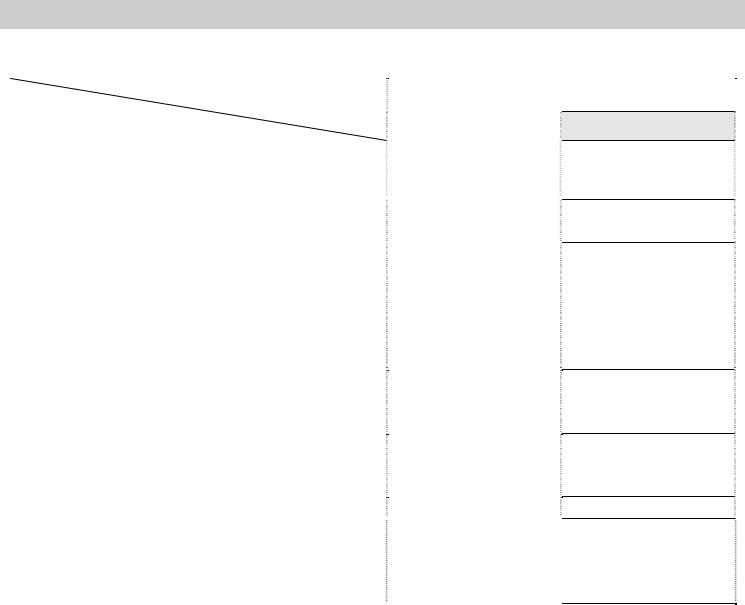
EN
What type of containers may be used?
Table – dishware
|
Operating mode |
|
|
|
Microwave |
|
||
|
Type of dish |
|
|
|
|
|
|
|
|
|
|
Defrost / heat |
|
|
|
|
|
|
|
|
|
Cook |
||||
|
|
|
|
|
|
|
|
|
|
Glass and porcelain 1) |
|
yes |
|
|
yes |
||
|
Domestic, non fire-resistant, may be washed in |
|
|
|
|
|
|
|
|
dishwasher |
|
|
|
|
|
|
|
|
Glazed ceramic |
|
yes |
|
|
yes |
||
|
Fire-resistant glass and porcelain |
|
|
|
|
|
|
|
|
Ceramic, earthenware dishes |
|
yes |
|
|
yes |
||
|
unglazed |
|
|
|
|
|
|
|
|
glazed without metallic decorations |
|
|
|
|
|
|
|
|
Earthenware dishes |
|
|
|
|
|
|
|
|
glazed |
|
yes |
|
|
yes |
||
|
unglazed |
|
no |
|
|
no |
||
|
Plastic dishes 2) |
|
|
|
|
|
|
|
|
heat-resistant up to 100°C |
|
yes |
|
|
no |
||
|
heat-resistant up to 250°C |
|
yes |
|
|
yes |
||
|
Plastic films 3) |
|
|
|
|
|
|
|
|
Cling film |
|
no |
|
|
no |
||
|
Cellophane |
|
yes |
|
|
yes |
||
|
Paper, cardboard, parchment 4) |
|
yes |
|
|
no |
||
|
Metal |
|
|
|
|
|
|
|
|
Aluminium foil |
|
yes |
|
|
no |
||
|
Aluminium containers 5) |
|
no |
|
|
yes |
||
|
Accessories (grille) |
|
no |
|
|
no |
||
1.No golden or silver edges and no lead glass.
2.Remember the manufacturer’s tips!
3.Do not use metal clips to close the bags. Perforate the bags. Use films only to cover foods.
4.Do not use paper plates.
5.Only shallow aluminium containers without lids. The aluminium must not come into contact with the walls of the cavity.
17
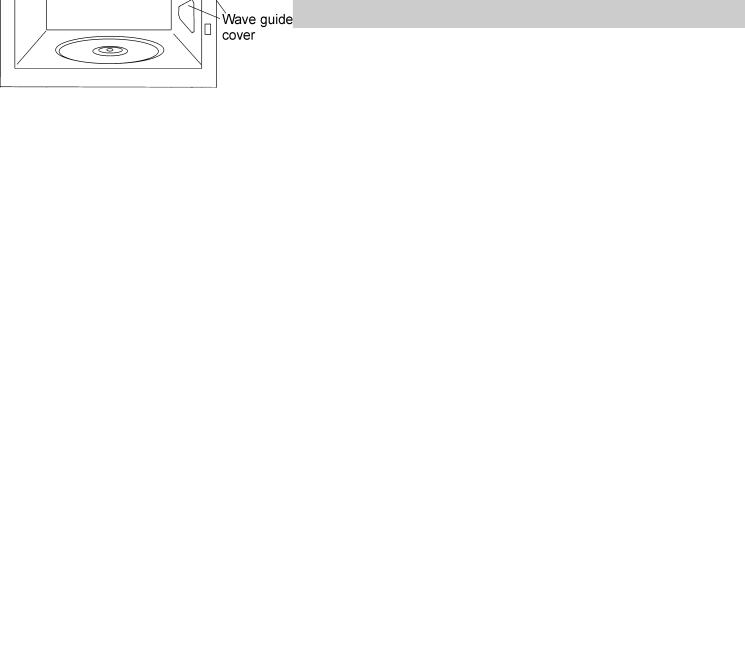
EN
Cleaning and care
BEFORE CLEANING the microwave, ENSURE
THAT THE PLUG IS NOT IN THE SOCKET.
After using the appliance, let it cool off. Do not clean the appliance with abrasive cleaning products, scourers that will scratch the surface or sharp objects.
Outer surface:
1.Clean the outer surface with a neutral detergent, lukewarm water and a damp cloth.
2.Do not allow water to pass through the outer structure.
Inside:
1.After each use, clean the inside walls with a damp cloth.
2.Do not allow water to enter the ventilation holes of the microwave oven.
3.If it has been some time since the last cleaning and the cavity of the microwave oven is dirty, put a glass of water on the tray and connect the microwave at maximum power for 4 minutes. The steam that is released will soften the dirt, which will be easy to clean with a soft cloth.
Important! The appliance should not be cleaned with steam cleaning machines. The steam may reach the charged parts and cause a short circuit.
The most soiled stainless steel surfaces may be cleaned using a non-abrasive cleaning product.
Then they should be rinsed with hot water and dried well.
18
4.Clean accessories after each use. If they are very dirty, steep them first and then use a brush and a sponge. The accessories may be washed in the dishwasher. Ensure that the rotating plate and respective base are always clean.
Door, door-hinges and front of the appliance:
1.These parts must always be clean, especially the contact surfaces between the door and the front of the appliance, so that there are no leaks.
2.To clean, use a neutral detergent and lukewarm water. Dry with a soft cloth.
Mica covers:
Always keep the mica covers clean. Food remaining in the covers may deform it or produce sparks if they go on fire. Therefore, they should be cleaned on a regular basis, but abrasive cleaning products or sharp objects should not be used. Do not remove the covers, to avoid any risk.

Troubleshooting
The appliance does not function properly:
•Is the power plug correctly inserted in the socket?
•Is the door properly closed? The door should make an audible click when it closes.
•Are there any foreign bodies between the door and the ring?
The foods do not heat up or they heat very slowly:
•Did you use a metallic dish by mistake?
•Did you select the right operating time and power level?
EN
The inside lighting does not come on:
•If all of the functions are operating correctly, the bulb is probably blown. You may continue to use the appliance.
•The light bulb may only be replaced by the Technical Support Service.
The power cable is damaged
•The power cable must be replaced by the manufacturer, authorised agents or technicians that are qualified to perform this task, in order to avoid dangerous situations and because special tools are needed.
•Did you place a larger or colder amount of
food than usual in the microwave? If any other type of fault is noticed, contact the
Customer Support Service.
The food is too hot, dry or burned:
•Did you select the right operating time and power level?
There are noises while the appliance is in operation:
•Is there an electrical arch inside the microwave?
All repairs must be performed by specialised technicians.
•Is the dish coming into contact with the walls of the cavity?
•Are there loose skewers or spoons inside the microwave?
19

EN
Technical Features
Description of functions of buttons
Symbol |
Description |
Power |
Foods |
|
|
Keep hot |
130W |
Slow defrosting for delicate foods, keeping food hot |
|
|
|
|
|
|
|
Minimum |
320W |
Melting butter |
|
|
Heating baby food |
|||
|
|
|
||
|
|
|
Cooking vegetables and other foods |
|
|
Medium |
600W |
Cooking and heating carefully, |
|
|
Heating and cooking small quantities |
|||
|
|
|
||
|
|
|
Heating delicate foods |
|
|
Maximum |
800W |
Cooking and heating liquids and other foods fast |
|
|
|
|
|
Specifications
• |
AC voltage ............................................................................................... |
See rating plate |
• |
Fuse......................................................................................................... |
12 A / 250 V |
• |
Power required......................................................................................... |
1200 W |
• |
Microwave output power. ......................................................................... |
800 W |
• |
Microwave frequency…............................................................................ |
2450 MHz |
• |
Outer dimensions (W×A×D). .................................................................... |
595 × 390 × 325 mm |
• |
Cavity dimensions (W×A×D). ................................................................... |
305 × 210 × 280 mm |
• |
Oven capacity. ......................................................................................... |
18 l |
• |
Weight...................................................................................................... |
18,6 kg |
20

FI
Hyvä asiakas,
aluksi haluamme kiittää sinua tuotevalintasi johdosta. Olemme varmoja, että tämä moderni, helppokäyttöinen, käytännöllinen ja korkealaatuisista materiaaleista valmistettu mikroaaltouuni täyttää odotuksesi.
Lue käyttöohje huolellisesti, sillä sen avulla saat parempia tuloksia, kun käytät mikroaaltouuniasi.
SÄILYTÄ TÄMÄN TUOTTEEN MUKANA TULEVAT ASIAKIRJAT VASTAISUUDEN VARALLE.
Pidä käyttöohje helposti saatavilla. Jos annat laitteen toiselle henkilölle, muista liittää mukaan myös käyttöohje!
Ohjeita ympäristönsuojeluun
Pakkauksen hävittäminen 
Pakkauksessa on Vihreä piste -merkki. Käytä oikeita jätteenkeräyssäiliöitä, kun hävität pakkausmateriaalia, kuten kartonkia, styroksia ja muovikalvoja, tai toimita ne asianmukaisiin keräyspisteisiin. Näin varmistat pakkausmateriaalien kierrätyksen.
Vanhojen sähkölaitteiden hävittäminen 
Sähköja elektroniikkaromua koskevan EUdirektiivin 2002/96/EY mukaan vanhoja kodin sähkölaitteita ei saa hävittää kaatopaikkajätteen mukana. Käytöstä poistetut laitteet on toimitettava erilliskeräykseen laitteiden sisältämien materiaalien uudelleenkäytön ja kierrätyksen varmistamiseksi ja terveysja ympäristövaikutusten vähentämiseksi.
Tuotteessa oleva symboli (jätesäiliö, jonka yli on vedetty henkselit), muistuttaa velvollisuudesta toimittaa käytöstä poistettu laite erilliskeräykseen.
Tietoja vanhojen laitteiden hävittämisestä saa paikallisilta viranomaisilta tai laitteen myyneestä liikkeestä.
Laitteen virtajohto tulee katkaista ja hävittää ennen laitteen hävittämistä.
21

FI |
|
Sisällys |
|
Turvallisuusohjeita ........................................................................................................................... |
23 |
Asennusohjeet .................................................................................................................................. |
25 |
Laitteen kuvaus................................................................................................................................. |
26 |
Mikroaaltouunin edut ....................................................................................................................... |
27 |
Mikroaaltouunin toiminta................................................................................................................. |
27 |
Käyttöohjeet ...................................................................................................................................... |
28 |
Kellon asettaminen........................................................................................................................... |
28 |
Turvalukko......................................................................................................................................... |
28 |
Toiminto: mikroaaltouuni................................................................................................................. |
29 |
Erityistoiminto: juomat..................................................................................................................... |
29 |
Erityistoiminto: sulatus ja lämmitys ............................................................................................... |
29 |
Sulatus ajan mukaan (manuaalinen)............................................................................................... |
30 |
Kun uuni on päällä............................................................................................................................ |
31 |
Toimintojen keskeyttäminen ........................................................................................................... |
31 |
Ohjelman päättyminen.................................................................................................................... |
31 |
Sulatus ........................................................................................................................................... |
31 |
Yleisohjeita sulatukseen ................................................................................................................. |
31 |
Ruoanvalmistus mikroaaltouunissa ............................................................................................... |
33 |
Tärkeitä ohjeita! .............................................................................................................................. |
33 |
Vihannesten valmistussuosituksia .................................................................................................. |
34 |
Kalan valmistussuosituksia............................................................................................................. |
34 |
Millaisia astioita saa käyttää?.......................................................................................................... |
35 |
Mikroaaltouunin toiminta................................................................................................................. |
35 |
Astioiden testaaminen .................................................................................................................... |
35 |
Alumiinirasiat ja -foliot..................................................................................................................... |
35 |
Kannet ............................................................................................................................................ |
35 |
Millaisia astioita saa käyttää?.......................................................................................................... |
36 |
Astiasuosituksia.............................................................................................................................. |
36 |
Puhdistus ja hoito............................................................................................................................. |
37 |
Häiriöt ................................................................................................................................................ |
38 |
Tekniset ominaisuudet..................................................................................................................... |
39 |
Painiketoimintojen kuvaus .............................................................................................................. |
39 |
Tekniset tiedot ................................................................................................................................ |
39 |
22

FI
Turvallisuusohjeita
•Varoitus! Älä koskaan jätä mikroaaltouunia ilman valvontaa leimahdusvaaran vuoksi.
Korkea tehotaso tai pitkä valmistusaika voivat kuumentaa ruokaa liikaa ja sytyttää sen palamaan.
•Jos uunissa näkyy savua tai tulta, pidä luukku suljettuna, jotta liekit tukahtuvat. Sammuta laite ja irrota pistoke pistorasiasta.
•Varoitus! Laitetta ei ole tarkoitettu lasten tai sellaisten henkilöiden käyttöön, joiden fyysinen tai henkinen toimintakyky on rajoittunut tai joilla ei ole kokemusta tai tietoa laitteen käytöstä, muutoin kuin heidän turvallisuudestaan vastaavan henkilön valvonnassa tai opastuksella. Valvo, etteivät lapset käytä laitetta leikkikaluna.
•Varoitus! Noudata erityistä varovaisuutta, kun käytät grillitoimintoa. Pidä lapset poissa laitteen luota!
•Laitteemme täyttävät teknisille laitteille asetut vaatimukset ja normit. Nämä eivät kuitenkaan kata kaikkia mahdollisia tapaturmavaaroja.
•Jos ruoan lämmitykseen tai valmistukseen käytetään helposti syttyviä materiaaleja, kuten muovitai pahvirasioita, uunia on palovaaran vuoksi valvottava koko prosessin ajan.
•Tarkista ennen astioiden ja rasioiden käyttämistä mikroaaltouunissa, että ne ovat mikronkestäviä.
•Varo, ettei virtajohto koske kosteisiin tai teräväreunaisiin esineisiin tai laitteeseen sen ollessa kuuma.
•Kun käytät muita sähkölaitteita mikroaaltouunin lähellä, vältä vahinkoja ja vaaratilanteita huolehtimalla, etteivät virtajohdot kosketa mikroaaltouunia sen ollessa kuuma ja etteivät johdot tartu uunin luukkuun.
•Vältä käyttövirheitä. Laitetta ei saa käyttää seuraavissa tilanteissa:
-jos luukku ei mene kunnolla kiinni.
-jos luukun saranat ovat vaurioituneet.
-jos luukun ja uunin etuosan välinen kosketuspinta on vaurioitunut.
-jos luukun lasi on vaurioitunut.
-jos uunissa näkyy usein valokaari, vaikka sisällä ei ole metalliesineitä.
•Tuuletusreikiä ei saa peittää.
Puhdistus ja ylläpito:
•Irrota pistoke pistorasiasta aina ennen puhdistustai ylläpitotoimenpiteitä.
•Noudata kohdassa Puhdistus ja hoito annettuja puhdistusohjeita.
•Kosketuspinnat (uunin etuosa ja luukun sisäsivu) on pidettävä täysin puhtaina virheettömän toiminnan varmistamiseksi.
Puhdista kosketuspinnat neutraalilla puhdistusaineella ja liinalla, joka ei naarmuta eikä hankaa.
•Varoitus: älä koskaan käytä laitetta, jos kosketuspinnat ovat vaurioituneet. Laitteen saa ottaa uudelleen käyttöön vasta teknisen tuen huoltoteknikon korjattua sen.
23
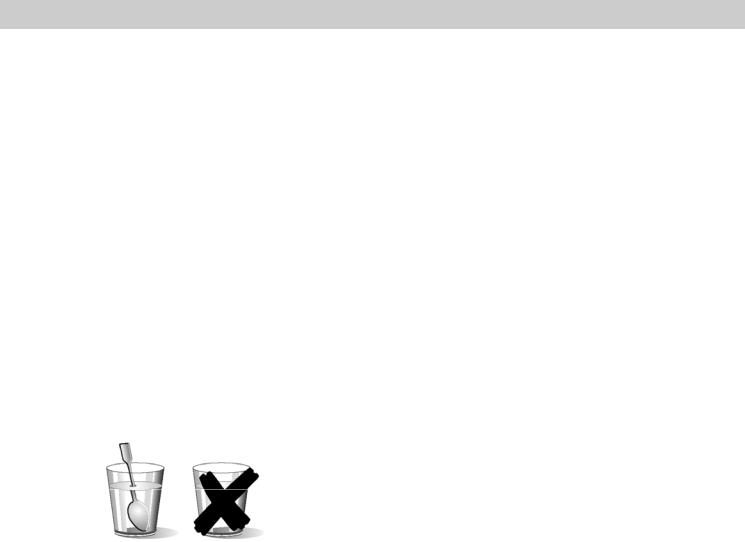
FI
Turvallisuusohjeita
Vältä laitteen vaurioituminen noudattamalla seuraavia ohjeita
•Älä käynnistä laitetta ilman pyörivää alustaa ja vatia.
•Älä käynnistä laitetta, jos se on tyhjä. Uuni voi siinä tapauksessa ylikuormittua.
•Käytä vain mikronkestäviä astioita.
•Älä säilytä helposti syttyviä esineitä uunissa, sillä ne voivat syttyä palamaan, jos uuni käynnistetään.
•Munia kuorineen tai kokonaisina keitettyjä munia ei pidä lämmittää mikroaaltouunissa, sillä ne voivat räjähtää.
•Älä lämmitä mikrossa puhdasta alkoholia tai alkoholijuomia.
TULIPALON VAARA.
•Varoitus: älä lämmitä nesteitä tai muita ruoka-aineita suljetuissa astioissa, sillä ne voivat helposti räjähtää.
Ole varovainen, kun lämmität nesteitä!
•Kun lämmität mikrossa nesteitä (vettä, kahvia, teetä, maitoa jne.), ne voivat kuumentua lähelle kiehumispistettä. Jos tuolloin otat astian ulos nopeasti, kuuma neste voi kuohahtaa yli. Tästä voi seurata vammoja ja palohaavoja!
•Voit välttää tällaisia tilanteita panemalla muovilusikan tai lasitikun astiaan, kun lämmität nesteitä.
24
Ole varovainen!
•Kun lämmität pieniä määriä ruokaa, vältä pitkiä lämmitysaikoja ja korkeita tehotasoja, jotta ruoka ei kuumene liikaa tai pala.
Esimerkiksi leipä voi palaa jo 3 minuutissa, jos valitset korkean tehotason.
•Käytä leivän paahtamiseen vain grillitoimintoa ja valvo uunia koko ajan. Jos käytät paahtamiseen yhdistelmätoimintoa (mikroa ja grilliä), leipä syttyy tuleen hyvin lyhyessä ajassa.
•Kun lämmität vauvanruokaa mikrossa, poista aina purkista kansi ja pullosta tutti.
Ravista tai hämmennä ruokaa lämmittämisen jälkeen, jotta lämpö jakautuu tasaisesti. Tarkista ruoan lämpötila, ennen kuin annat sitä lapselle. Palovamman vaara!
Korjaukset:
•Vaara – mikroaaltoja! Ulkosuojusta ei saa poistaa. Muun kuin valmistajan valtuuttaman henkilön on vaarallista suorittaa korjauksia tai huoltoa.
•Varoitus: lampun saa vaihtaa vain tekninen tuki.
•Jos virtajohto on vaurioitunut, sen saa vaihtaa vain tekninen tuki ominaisuuksiltaan samanlaiseen johtoon, jotta mahdolliset vahingot voidaan välttää.
•Vain valmistajan valtuuttama huoltoteknikko saa korjata ja huoltaa laitetta, etenkin osia, joissa on virtaa.

Asennusohjeet
Avaa luukku avauspainikkeella ja poista pakkausmateriaalit. Puhdista uunin sisäosat ja varusteet kostealla liinalla. Kuivaa. Älä käytä hankaavia tai voimakkaanhajuisia tuotteita.
Tarkista, että seuraavat osat ovat vahingoittumattomia:
•luukku ja saranat
•mikroaaltouunin etuosa
•laitteen sisäja ulkopinnat
ÄLÄ KÄYTÄ LAITETTA, jos jokin edellä mainituista osista on vaurioitunut. Ota siinä tapauksessa yhteys tekniseen tukeen.
Aseta laite tukevalle, tasaiselle pinnalle.
Aseta pyörivä alusta keskelle uunia ja pyörivä vati sen päälle. Kuulet napsahduksen, kun vati on paikallaan. Mikroa käytettäessä pyörivän alustan ja vadin on oltava aina uunissa ja kunnolla paikallaan. Vati pyörii molempiin suuntiin.
Varoitus! Mikroaaltouuni voidaan pakata suojakalvoon. Poista suojakalvo varovasti pohjasta alkaen, ennen kuin kytket uunin päälle ensimmäisen kerran.
FI
Laitteen tuuletus on varmistettava asentamalla se keittiökalusteeseen niin, että yläpuolelle jää avoin tila (katso liitesivut)
Varoitus: huolehdi mikron asennuksen jälkeen, että pistorasiaan on vapaa pääsy.
Varmista asennuksen yhteydessä, ettei virtajohto pääse koskettamaan laitteen takaosaa, sillä korkeat lämpötilat voivat vaurioittaa johtoa.
Jos aiot asentaa mikroaaltouunin ja tavallisen uunin torniksi, mikro on sijoitettava uunin alapuolelle vesihuurun muodostumisen vuoksi.
Laitetta ei saa sijoittaa lämpöpatterien tai radioja televisiovastaanottimien lähelle.
Laiteeseen sisältyy virtajohto ja pistoke (yksivaihevirta).
VAROITUS: Mikroaaltouunin SAA LIITTÄÄ
VAIN MAADOITETTUUN PISTORASIAAN.
Laitteen vikaantuessa valmistajan ja myyjän vastuu raukeaa, jos asennusohjeita ei ole noudatettu.
25
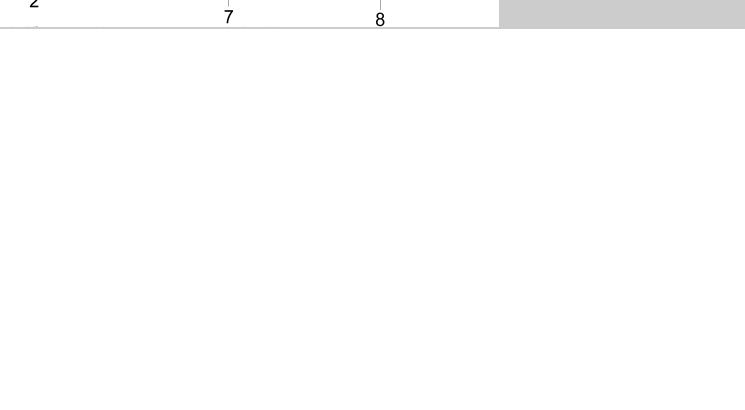
FI
Laitteen kuvaus
1. |
Luukun lasi |
5. |
Avauspainike |
2. |
Lukko |
6. |
Pyörivän alustan kolo |
3. |
Kiillelevyt |
7. |
Pyörivä alusta |
4. |
Ohjauspaneeli |
8. |
Pyörivä vati |
26
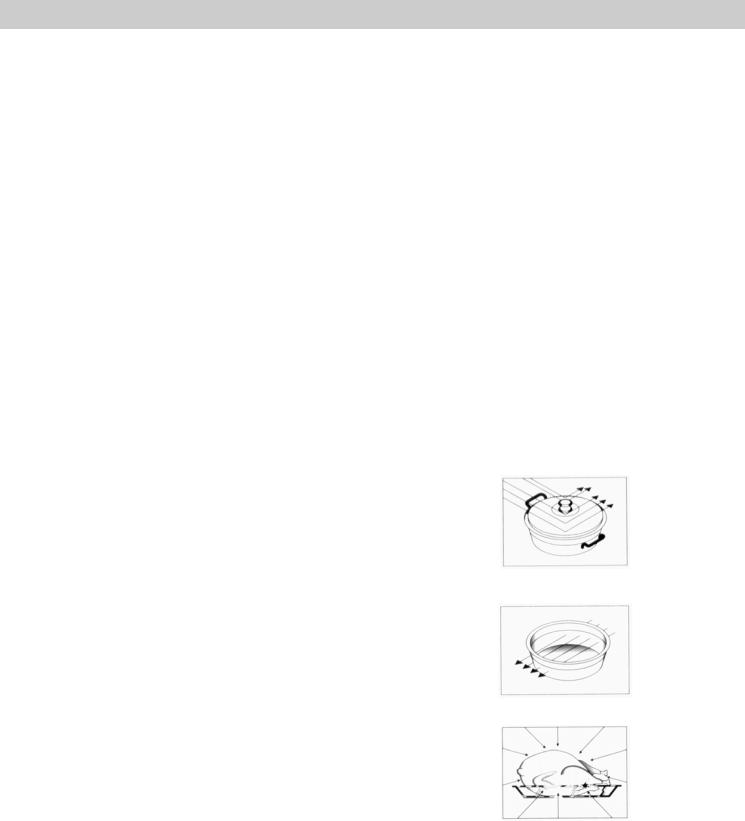
Mikroaaltouunin edut
Tavallisessa liedessä vastusten tai kaasupolttimien kautta säteilevä lämpö tunkeutuu ruoan sisään hitaasti ulkoapäin.
Mikroaaltouunissa ruoka itse kehittää lämpöä, ja siten lämpö kulkee sisältä ulospäin. Lämpöä ei häviä ilmaan, uunin seiniin tai astioihin (jos astiat ovat mikronkestäviä). Tämä tarkoittaa, että vain ruoka lämpenee.
Mikroaaltouunien etuja ovat:
1.Lyhyet valmistusajat, yleensä 3/4 lyhyempiä tavallisiin valmistustapoihin verrattuna.
2.Pakasteiden pikasulatus, joka pienentää bakteerien kehittymisvaaraa.
3.Energian säästö.
4.Ravintoarvojen säilyminen ruoassa lyhyempien valmistusaikojen ansiosta.
Mikroaaltouunin toiminta
Mikroaaltouunissa on magnetroniksi kutsuttu suurtehotyhjiöputki, joka muuntaa sähköenergian mikroaaltoenergiaksi. Aaltojohto vie nämä sähkömagneettiset aallot uunin sisäosiin, jossa metallihajautin tai pyörivä vati hajauttaa ne.
Uunissa mikroaallot leviävät kaikkiin suuntiin ja heijastuvat takaisin metalliseinistä tunkeutuen siten tasaisesti ruoka-aineiden sisään.
FI
Miksi ruoka lämpenee?
Useimmat ruoka-aineet sisältävät vettä. Mikroaallot panevat vesimolekyylit värähtelemään.
Molekyylien hangatessa toisiaan syntyy lämpöä, joka nostaa ruoan lämpötilaa sulattaen tai kypsentäen sen tai pitäen sitä lämpimänä.
Koska ruoka lämpenee sisältä päin,
•ruoka-aineet voidaan kypsentää ilman nestettä tai öljyä, tai niiden määrä on erittäin pieni.
•sulatus, lämmitys ja kypsennys ovat mikroaaltouunissa tavallista uunia nopeampaa.
•vitamiinit, kivennäisaineet ja ravintoaineet säilyvät.
•luonnollinen väri tai aromi ei muutu.
Mikroaallot läpäisevät posliinin, lasin, pahvin ja muovin, mutta eivät metallia. Tästä syystä mikroaaltouunissa ei pidä käyttää metalliastioita tai astioita, joissa on metalliosia.
Mikroaallot heijastuvat takaisin metallista...
... ne läpäisevät lasin ja posliinin...
... ja imeytyvät ruoka-aineisiin.
27

FI
Käyttöohjeet
Varoitus: Älä koskaan käytä mikroa tyhjänä. Seuraa kaaviokuvaa ja toimi seuraavasti:
1.Liitä laite tarkoitukseen sopivaan pistorasiaan
(katso ohjeet viimeisellä sivulla).
2.Avaa luukku painamalla AVAUSPAINIKETTA.
Mikroaaltouunin sisävalo syttyy.
3.Aseta ruokaa sisältävä astia pyörivälle vadille.
4.Valitse toiminto ja valmistusaika seuraavissa kohdissa annettujen ohjeiden mukaan.
5.Sulje luukku ja paina KÄYNNISTYS (start)
-painiketta.
6.Mikroaaltouuni käynnistyy ja ohjauspaneelin näytössä näkyy jäljellä oleva aika.
Kellon asettaminen
1.Kun uuni ei ole päällä, paina KELLO-painiketta, kunnes numerot alkavat vilkkua.
2.Aseta tunnit kääntämällä SÄÄTÖNUPPIA jompaankumpaan suuntaan.
3.Paina uudelleen KELLO-painiketta, jotta voit asettaa minuutit.
4.Aseta minuutit kääntämällä SÄÄTÖNUPPIA jompaankumpaan suuntaan.
5.Paina lopuksi vielä kerran KELLO-painiketta.
Turvalukko
Turvalukko voidaan ottaa käyttöön tai poistaa käytöstä painamalla turvalukkopainiketta kolmen sekunnin ajan mikron ollessa valmiusasennossa.
Tämä poistaa käytöstä kaikki toiminnot ja näyttöön tulee numeroiden tilalle neljä vaakaviivaa ja pisteet vilkkuvat.
28
